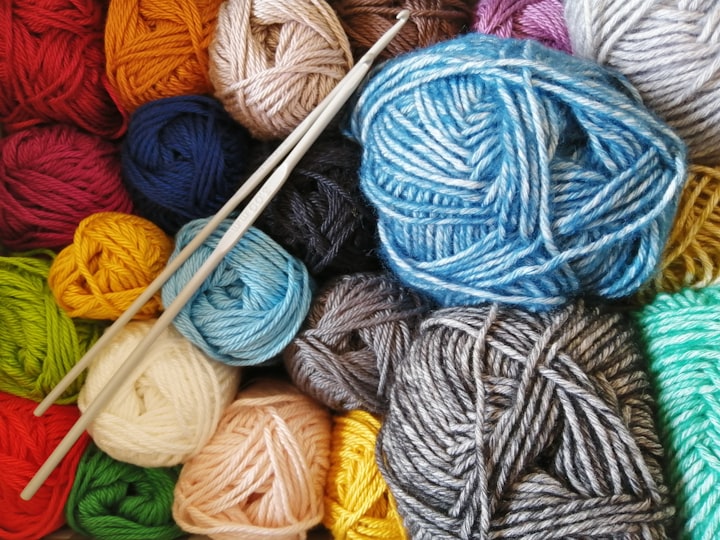Yarn is so pretty! How do I choose?
How to effectively choose yarn for your first crochet or knitting project

The first time I went to a store to pick out yarn for a project, I didn’t know how difficult it would be because of all of the options! I went by myself and I didn’t have friends that I knew of who were knitters and crocheters (I was also too shy to ask around), so I was mostly on my own for choosing the color, the weight, softness, and the type of yarn I was going to use. But, as a beginner crafter, those weren’t the terms I was using in my head. My criteria was Does it look pretty? Does it fit my budget (which, being a college student at the time, was as inexpensive as possible.)? My choice for my first project was a variegated light purple/white/dark purple. I brought it home, made a scarf for myself and, besides the lop-sidedness of it, I didn’t like it. Why? It was too rough and scratchy.* Since I had chosen my yarn based solely on color and price, the overall quality and fit for the project suffered. I didn’t know better and I’m here to provide some tips so that others aren’t as disappointed in their final products as I was.
*Note: This yarn-purchasing adventure of mine was about 20 years ago and yarn softness has improved significantly since.
Even though I chose my yarn by color and price--and that is a valid way to choose!--it would also have benefitted me to have chosen a PROJECT that matched the yarn. While that sounds backwards, it becomes less odd as you, the crafter, begin to accumulate more and more material that doesn’t quite get fully used up in projects. Then you start to base the projects on the yarn you have. The accumulated yarn is commonly referred to as one’s “stash.” While browsing patterns or techniques, it is common to see “stash-buster” projects, suggesting that the yarn to be used can vary and it is encouraged to!
But what if you already know what you want to make? I knew I wanted to make a scarf, but I didn’t know how much yarn I would need nor did I even consider if the yarn would be soft enough--I just assumed it would be. Here are some of the questions I wish I had known to ask while looking at yarns for my first project:
- Is it soft enough? I’m going to be wearing this around my neck, I need to compare and see if the final product will be something that I can tolerate, but preferably I ENJOY wearing.
- Does this one skein have enough to complete the project? While my first projects were scarves that I made until I felt they were long enough, one skein of worsted weight was sufficient for all of them. Running out of yarn wasn’t something that I worried about until much later. If you don’t know how much you will need, researching similar patterns on sites such as Ravelry can give you an approximation of how much yarn a project requires.
- Will the yarn I’m looking at fit with the hooks that I own (or vice versa)? I mentioned “worsted weight” above. This is a description of the yarn weight or thickness of the strands. Some are classified as “cobweb” yarn, which is extremely thin and used for lace. There is “sock” yarn, which, surprise, is ideal for socks. The yarn that can be found in most chain stores will be worsted weight, also known in the US as a 4 weight yarn. The Craft Yarn Council has a list of weights of yarns.
- Is it easy to work with/what are others’ experiences with it? I was a stubborn individual and probably would have disregarded any advice I got in this area. However, looking back, I wish I would have listened to some of it. One of the most gorgeous and soft yarns I encountered early on was Lion Brand’s Homespun; it has beautiful colors, a pleasant texture and is quite affordable. However, the loose pieces of the fiber that make it so soft also get easily caught in the hooks and needles while working with it and is extremely frustrating to work with.
Knowing the answers to these questions beforehand would have prevented dissatisfaction with my first finished product, a lot of anxiety regarding the quantity required, guessing if my tools were correct as well as feelings of being unskilled. While this list of questions is mostly for those who might be considered beginners, I find it useful to go back to basics when I have a challenging set of circumstances. In addition to these questions, which are mostly a solo research activity, it is important to remember that there are communities online (and likely in person once gatherings are permitted again) dedicated to knitting and crochet where you can have conversations around specific yarns and techniques. Unlike my stubborn younger self, you don’t have to go it alone.
------
Disclosure: This post may contain affiliate links that at no additional cost to you, I may earn a small commission. I only recommend products I would use myself. All opinions expressed here are my own.
About the Creator
Rachel Pieper Decker
Displaced Minnesotan in Southern California.
Gamer, streamer, fiber arts enthusiast, Web3 dabbler, aspiring Notary Public
Connect with me: twitter.com/HyperZenGirl * twitch.tv/HyperZenGirl
Affiliate links: https://linktr.ee/HyperZen






Comments
There are no comments for this story
Be the first to respond and start the conversation.